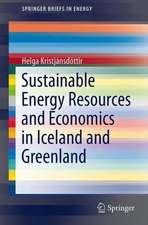Floating PV Plants
Editat de Marco Rosa-Clot, Giuseppe Marco Tinaen Limba Engleză Paperback – 30 ian 2020
One important new technology is the floating photovoltaic (FPV) which is at its very beginning but which after only 10 years from its first proposal has already reached the target of 2 GWp of plants installed.
This book explores the reasons for such growth and the advantages of this new technology. FPV plants are easily integrated into any human settlements and can use available fresh water as well as salt water near coastal areas. So their geographic potential is unlimited.
Furthermore, their environmental impact is limited and the managing and decommissioning of plants are very cheap.
The book offers a perspective on the many facets of this technology as well as an analysis of the economic aspect and of the final electricity cost which in a short time will go down to less than 50 $ per MWh.
Contributions from different authors have helped in sectors such as the raft structure, the wave impact, and the environment problems.
- Investigates the installation of photovoltaic systems over the water’s surface
- Offers theoretical and practical explanations on how to study, analyze and design photovoltaic energy systems
- Considers how the use of floating photovoltaic systems can work to fulfill domestic energy demand
Preț: 373.30 lei
Preț vechi: 516.95 lei
-28% Nou
Puncte Express: 560
Preț estimativ în valută:
71.45€ • 77.64$ • 60.06£
71.45€ • 77.64$ • 60.06£
Carte tipărită la comandă
Livrare economică 14-28 aprilie
Preluare comenzi: 021 569.72.76
Specificații
ISBN-13: 9780128170618
ISBN-10: 0128170611
Pagini: 138
Dimensiuni: 191 x 235 x 19 mm
Greutate: 0.25 kg
Editura: ELSEVIER SCIENCE
ISBN-10: 0128170611
Pagini: 138
Dimensiuni: 191 x 235 x 19 mm
Greutate: 0.25 kg
Editura: ELSEVIER SCIENCE
Public țintă
Electrical Engineers, power engineers, practitioners in renewable energy photovoltaics, solar energy, graduates and researchers in solar energy development and implementation.Cuprins
1. Introduction
2. Floating Plants Location
3. Current status of FPV and trends
4. The Floating PV Plant Structures
5. Wind load, wave impact and mooring systems
6. Cooling systems
7. Tracking systems
8. Available experimental test
9. Hydroelectric integration
10. The environmental problems
11. LCOE Analysis
12. Off shore FPV systems
2. Floating Plants Location
3. Current status of FPV and trends
4. The Floating PV Plant Structures
5. Wind load, wave impact and mooring systems
6. Cooling systems
7. Tracking systems
8. Available experimental test
9. Hydroelectric integration
10. The environmental problems
11. LCOE Analysis
12. Off shore FPV systems





























